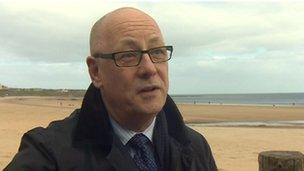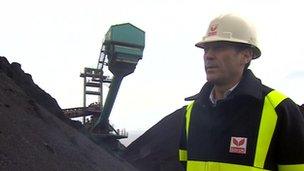North East coal's future assessed 20 years after closure
- Published

Harry Bradbury said it is hoped hundreds of jobs will be created
Twenty years ago mining at the Durham coalfield that once boasted more than 200 deep shaft mines stopped for the last time. Easington was the last pit to close.
Two decades on, and coal has not ceased to be important. Much of it is now imported, the rest comes from opencast mining.
But one company has big plans to exploit the remaining north-east of England coal reserves.
Harry Bradbury is looking out to sea from the beach at Tynemouth in North Tyneside. But it is not just the view he is taking in.
His company, the Newcastle-based Five Quarter, has been given licences by the government to drill for and extract gas from massive coal reserves under the sea and off the North East coast. In his mind's eye, he can see the vast potential beneath the waves.
"It's an unusual fact that despite the industrial revolution and everything that's happened since, 75% of British coal is still underground," he said.
"Under the North Sea there are vast deposits. We're talking about two billion tonnes of coal off the coast here. Now, to give you some measure of that, two billion tonnes has more energy in it than we've ever extracted from the totality of North Sea gas since we began."
Job hopes
It sounds incredible, but the government is convinced that the process of producing gas from source rocks - such as coal - has merit. And it is also fired by a need to secure the country's own energy sources.
It has given Five Quarter a £15m Regional Growth Fund grant to help accelerate the process, and, once again, create jobs in an industry exploiting coal.
"We're looking at job totals ranging from about 400 to about 1,000 here in the North East," said Dr Bradbury.
"We hope very much we can make use of the skills that already exist here in the North East from the former coal mining industry."
However, it could take a number of years before the country utilises gas from sub-sea coal. So in the interim, coal in its solid form still has an important part to play in supplying the country's energy needs.
The country's biggest surface mine, at Shotton in Northumberland, currently supplies about a tenth of the 17m tonnes of coal that came from the UK's 31 opencast mines last year.
The operator of the mine, the Banks Group, is currently looking to extend the life of Shotton to 2017 to fulfil the need of energy users and to safeguard 150 jobs there.
The plan comes after another County Durham miner, Hargreaves, said it wants to open new mines.

Phil Dryden said their dream was to use North East coal
It has had a £42m cash injection from shareholders to help develop new sites. Two sites in the North East have been identified and should be announced soon.
'North East stamp'
However, the coal that could be mined is still not enough to satisfy the country's coal users - mainly power stations. To bolster supply, the UK imported nearly 45m tonnes of coal last year from as far away as North America and Australia.
On Teesside, the steelmaker SSI is a company that relies heavily on those imports. It ships in about 2.5m tonnes a year which is turned into coke and then used in the blast furnace.
SSI UK chief executive Phil Dryden said: "To create the quality that we want there's no other option than to bringing coal in from Australia, which probably has the best coking coals in the world."
But the fuel is about to become even more important to SSI.
A new piece of kit has been installed at the plant that will blow ground coal into the blast furnace, replacing the need for much of the more expensive coke.
That means iron and steelmaking will become cheaper, the business should become more profitable, and coal from closer to home can be used in the process.
"We still have a dream that we're going to take North Eastern coal and stick it in a North East-based blast furnace. About 40% of the carbon charge could now have a North East stamp on it," said Mr Dryden.
It may be 20 years since the Durham coalfield workings fell silent but Dr Bradbury's plans, opencast's ambitions, and the needs of users such as SSI imply that the last chapter in the history of British coal appears far from written.
- Published17 April 2013
- Published16 May 2011